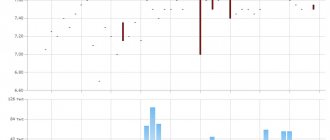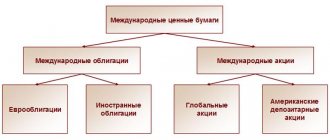Greetings! You have noticed that according to the way they assimilate information, people are clearly divided into two types: some find it easier to study material in a book format, while others find it easier when something is explained to them in words (live at a training session or in a training video).
What am I getting at? Moreover, the bond market is a rather complex and “expensive” (but very promising) topic. And it’s better to start it after studying the introductory “materials”: in the form of a book or video course. Today I will recommend you both. So, the bond market: a course for beginners to choose from.
What are bonds and what are they for?
Let's start with the basics and, for simplicity of presentation, consider this example. Let's say Ivan Ivanovich decided to build a house, but, unfortunately, he does not have enough money for this wonderful undertaking. Then he goes to his neighbor Semyon Semyonovich and asks him to borrow the missing amount of money (let it be 5 million rubles).
Here we should immediately make a reservation: only legal entities can issue bonds. Individuals do not have such an opportunity and appear in the example under consideration solely for the simplicity and clarity of the explanation given.
Semyon Semyonovich does not refuse his neighbor and gives him the required amount, but in return he asks for a paper in which Ivan Ivanovich vows to return the amount of 6 million rubles in exactly one year. This paper, which specifies the term and amount of its repayment, in a simplified form, is a bond.
The above example will describe the essence of bonds even more precisely if we add to it the possibility of selling the paper issued by Ivan Ivanovich to Semyon Semyonovich on the secondary market.
In essence, bonds are nothing more than a way to borrow money without any collateral. This is the state’s favorite way to replenish the budget. With the help of bonds, the state borrowed money from the population even in Soviet times. Our grandparents bought war bonds issued during the Great Patriotic War. And parents may have encountered government bonds of a winning loan.
Your parents have almost certainly encountered winning bonds. Do you remember the famous film by Eldar Ryazanov with the inimitable Evgeny Leonov in the title role “Zigzag of Fortune”?
Currently, not only the state (OFZ) but also municipal and commercial organizations are credited with the help of bonds. We can also say that a bond is a security that regulates monetary relations between two parties. The first party is the issuer of the bond (those who put it on the market), and the second party is the investor (the one who bought this bond). Moreover, these monetary relations are mutually beneficial (otherwise no one would issue and no one would buy bonds). The benefit of the first party is that it receives money on credit without collateral and at an acceptable interest rate, and the benefit of the second party is to receive a profit (in the form of a coupon income or in the form of the difference between the purchase price and the redemption price).
Bond classification
Currently, there are several main types of bonds, they can be divided into:
- To the one who issues them (the issuer)
- How income is paid on them
- Whether they can be exchanged for other securities (for example shares) of the same issuer.
Bonds can be issued by:
- Government (government bonds). They are issued to replenish the state budget (cover its deficit) and are guaranteed by the state, and therefore are considered the most reliable (but also the lowest profitable). In Russia, these are federal loan bonds OFZ.
- Individual regions and autonomous okrugs (subfederal bonds). Slightly more risky (compared to OFZs), but, as a rule, also more profitable;
- Municipal structures (municipal bonds). This type of bonds is issued on behalf of local governments (city or district authorities). The peculiarity of this type of bonds is that income from them is usually exempt from taxes.
- Private companies (corporate bonds). As the name suggests, this type of paper is issued by private companies. The income on these bonds is considered the highest of all those listed, but the risk is also higher (the payment of income is guaranteed not by the state, but by the issuing company).
Bond income can be paid in two main ways:
- In parts in the form of a certain percentage during the entire period of ownership of the bond (coupon or interest bonds). Let's go back to the example with Semyon Semyonovich and Ivan Ivanovich (Semyon and Ivan, for short). If in this example Ivan offered Semyon to pay a certain percentage of the amount he took, say once a month, based on the calculation of 20% per annum (i.e. 20%/12 = 1.66% per month). Then in a year Ivan would return to Semyon the same 5 million that he borrowed, but Semyon’s benefit would be in the percentage he received from Ivan for the year (20% of 5 million is one million rubles).
- One-time at the end of the validity period through redemption at par price (initially such bonds are sold at a price below par (with a discount)). In the example with Semyon Semenovich and Ivan Ivanovich, exactly this situation was initially described. The paper in which Ivan undertakes to pay Semyon 6 million rubles in a year is analogous to a bond with a par value of 6 million rubles. And one million, which ultimately constitutes Semyon’s income, is nothing more than a discount.
Coupon bonds, in turn, are divided into two more types:
- With a fixed percentage. We have already looked at an example of a situation with a fixed interest above (this is when Ivan paid Semyon monthly 1.66% of 5 million).
- With floating interest. In this case, the final income that will ultimately be received on the bond is unknown (unlike all other cases considered). In the example with Ivan and Semyon, this would mean something like the following. Ivan would pay Semyon interest based not on a fixed rate of 20% per annum, but on a floating rate tied, for example, to the key rate of the Central Bank of the Russian Federation. That is, if the key rate decreases during the year, then Semyon will receive less income. And if the key rate increases, then Ivan will be forced to pay more than would be the case with a fixed rate.
It should also be added that there are so-called convertible bonds. They pay a fixed interest and can, during the entire period of validity, be exchanged for shares or other securities of the same issuer. The conversion rate, as well as the date after which this exchange can be made, are agreed upon in advance (at the time of purchasing the bond). After such an exchange, the bond is canceled along with the issuer's obligations under it. In our example, if Ivan Ivanovich immediately offered Semyon Semyonovich the opportunity to take back his city apartment as a debt, but not immediately, but say after a month and a half (when the tenants vacate it), then this would be an analogue of a convertible bond.
In addition to this basic classification of bonds, you can add such criteria for distinguishing between them as:
By currency, bonds denominated:
- In national currency. These are government and corporate bonds (issued by issuers within the country);
- In foreign currency. These include both bonds issued by foreign issuers and national securities issued in the form of Eurobonds.
By level of security:
- Not provided with anything. The most unreliable of all, but also, as a rule, the most profitable;
- Secured by part of the issuer's property;
- Guaranteed. They assume a guarantee of fulfillment of all obligations on the part of the issuer. In this case, a third party acts as a guarantor. The reliability of this kind of securities greatly depends on who exactly acts as a guarantor for them (after all, it is one thing if it is a reputable bank and quite another if it is a one-day company).
If early repayment is possible:
- Repayable exactly on time;
- With the right of early repayment on the part of the investor. This right is usually exercised in the form of an attached put option;
- With the right of early repayment on the part of the issuer. Reserving the opportunity to reduce the debt burden, the issuer can pre-specify in the rules for issuing bonds a clause providing for their early redemption from investors. After all, if it becomes possible to repay the debt earlier, then why continue to pay interest on it.
By call time:
- Short term. These usually include securities whose circulation period does not exceed one year;
- Medium term. This category includes bonds with maturities from one to five years;
- Long-term. Securities with maturities of five years and above;
- Perpetual (perpetual bonds). These bonds either do not have a set maturity date at all, or they do have a maturity date, but they are very long (for example, Coca-Cola bonds with a set maturity date of 100 years).
Buy mutual funds
If you don’t want to understand trading programs or search for the right security, you can invest in bonds through a management company (MC). To do this, it is enough to buy a share in a mutual fund (mutual investment fund). A mutual fund is a large portfolio with bonds of companies from different industries. The manager will take on all the headaches.
The managers themselves claim that investing in bonds through them is not only more convenient, but also more profitable than investing on your own, because a professional is looking after the funds.
“Last year was very successful for the bond market, and the yield of bond mutual funds was 13-14%,” says Alfa Capital analyst Andrey Shenk.
However, no manager can promise a guaranteed return, so you can earn more or less on a mutual fund than on independently purchased bonds.
From the amount of income you need to subtract commissions, which in the case of management companies are much higher than in the case of brokers. A management commission is added (1-2% of the fund’s assets), discounts/surcharges that are paid by the investor at the time of purchase/redemption of fund shares. In total, about 1.5-2% will have to be subtracted from the profit received for the management and redemption of the share. However, the share can also be put into an IIS and receive a tax deduction in the amount of the same 13% per annum.
Bond issue
The issue of bonds is usually called the procedure for putting them into circulation (on the stock exchange or on the over-the-counter market). Below are the main conditions that must be met by the issuer to be able to issue its own bonds. In addition, the issuance procedure approved by the Bank of Russia is given.
Sequence of bond issue
Conditions under which the issue of bonds is possible
In order to protect the interests of investors, the law establishes certain requirements for companies wishing to issue their own bonds. These requirements are quite simple and logical, here is a list of them:
- The possibility of issuing debt securities in an amount whose nominal value exceeds the authorized capital of the company is not permitted. That is, a company with an authorized capital of 100 million rubles can issue, for example, no more than 100,000 bonds with a par value of 1,000 rubles;
- Bonds can be issued only after full payment of the authorized capital;
- Before being able to carry out a full issue of its own bonds without collateral, the issuing company must have existed for at least 3 years and have at least two approved annual balance sheets;
- If we are talking about the issue of bonds convertible into shares, then their number should not exceed the number of corresponding shares.
Procedure for issuing bonds
In accordance with the regulation of the Central Bank of the Russian Federation No. 428-P (“On standards for issuing securities...”), the issue of bonds must be carried out according to the following algorithm:
- The issuer of bonds, represented by the board of directors or other governing body, makes a decision on the need for issue;
- Next, the decision must be approved. In joint stock companies, it is submitted to the general meeting of shareholders and a vote is taken on it. If supported by a majority of votes, the decision is considered officially approved;
- After this, it is necessary to prepare all the documents for the official state registration of the bond issue and submit them to the relevant department of the Bank of Russia (in charge of issue registration issues). In this case, a mandatory state duty is paid;
- If the registration of the issue was successful (i.e. the Central Bank did not see any inconsistencies with the norms of Russian legislation), then the issuer proceeds directly to the issue itself** and the placement of bonds on the stock market;
- It would seem that that’s all – the bonds are officially registered and placed on the market. But no, in addition to all the above-mentioned actions, the issuer is obliged to prepare and submit to the regulatory body (the same department of the Central Bank of the Russian Federation) a report on the results of their issue.
** Bonds can be issued both on physical media (paper with appropriate degrees of protection) and in electronic form. Currently, most securities are issued in electronic form.
Open IIS
An individual investment account (IIA) is a type of brokerage account, but it was intended by the authorities so that ordinary citizens (like you and me) would start buying stocks and bonds. For this purpose, the state has come up with benefits for those who open an IIS. The rules are as follows: if you deposited up to 400 thousand rubles into your account. and do not withdraw funds within 3 years, then you will be returned a tax deduction in the amount of 13% of the amount in the account. The deduction can be obtained already in the first year by submitting a declaration to the tax office.
Such an account can also be opened through a broker. There is a limit on the number of IIS - one account per person. You can deposit up to 1 million rubles on an IIS, but you will only receive a deduction for 400 thousand rubles. True, in a year you can report another 400 thousand and receive another deduction. However, the second amount must also be kept in the account for 3 years from the date of deposit, etc. If within three years you still withdraw funds, the deduction will have to be returned to the state.
“In addition to coupon income on OFZ, which is not subject to personal income tax, an investor can receive a tax deduction in the amount of 13% of the amount deposited into the IIS. Thus, only in the first year of owning OFZ on an IIS, you can get approximately 21% per annum. Of course, in a year the profitability will decrease, because it will not be possible to receive a tax deduction every year on the previously deposited amount. And yet, the profitability of investing in OFZs through an IIS exceeds the best bank offers for deposits,” explains Alexander Dubrov, head of the online trading department at Otkritie Broker.
You can put not only government bonds on an IIS, but also corporate securities. However, on the one hand, you can get a tax deduction for them, on the other hand, you will have to pay personal income tax on coupon income.
Basic terms and definitions
In relation to bonds, they usually talk about the following four types of value:
- The cost is nominal;
- Maturity value. The price at which securities are redeemed at the end of their circulation period;
- Issue price. The price that the securities had at the time of their issue;
- Market price. The current price at which securities can be purchased or sold.
The face value reflects the same amount of money that the issuer borrows through the sale of one bond. It is also the maturity value, except in cases where the bonds are issued at a premium. It (par value) is also the issue price, with the exception of discount bonds.
The market value of bonds may be higher or lower than their face value. It depends primarily on the direction in which interest rates in the country have changed after the bond issue. If interest rates rise, the market value falls below par. If interest rates, on the contrary, fall, then the market price of bonds exceeds their face value.
Profit on bonds can be obtained in two main ways:
- In the form of coupon income;
- In the form of the difference between the issue price and the price to maturity (for discount bonds and bonds with a premium).
Coupon income is the interest income that the issuer undertakes to pay to the investor. It is usually expressed as a percentage per annum, and can be paid quarterly, semi-annually or annually. Sometimes the payment of all interest may coincide with the maturity date.
Coupon income got its name from the time when bonds were issued in paper form and special coupons were cut off when paying regular interest.
Open a brokerage account
You can purchase bonds by opening an account with a brokerage company. To do this, you must first choose a broker. The full list can be viewed on the Moscow Exchange website.
Top 15 brokers with the lowest commissions
To conclude a contract, you will need a passport. The broker will open a brokerage account and help you install a trading program on your computer, and also explain how to buy a particular security.
The broker earns from client commissions from trading operations. In order not to overpay, you must ask to select a tariff for your specific needs. Let them know that you intend to make a minimum number of transactions, that is, buy and sell the paper in a year or two. The bond can be purchased through your personal account after you have installed the trading application on your computer, following the instructions of the broker. When you decide to withdraw funds, inform the broker about this desire. The money will be transferred from the brokerage account to the bank account, and from there it can be withdrawn at the cash register or through an ATM.
The commission for the purchase/sale of bonds ranges from 0.025% of the transaction amount. You also need to pay 100-177 rubles. per year for storing securities in the depository. An additional small amount will have to be paid for withdrawing funds (approximately 10-50 rubles). The amount of commissions depends on the broker and transaction amounts.
Differences between bonds and stocks and bank deposits
Let's look at the features of bonds by comparing them with financial instruments such as shares and bank deposits. Both have a number of certain similarities with bonds. Most of all, they have in common with bank deposits, and in both cases the investor acts as a creditor, investing his money at a certain percentage. What bonds and shares have in common is that both are circulated on the secondary market, that is, they can be bought and sold as many times as necessary during the entire period of their circulation.
But unlike a bank deposit, investing in bonds has the following features:
- Bank deposits of individuals are subject to the compulsory insurance program, but investments in bonds are not. However, government bonds can be considered an equally reliable investment, since the probability of bankruptcy of an individual bank is much higher than the probability of default of the entire country. At the same time, only investments up to the amount of 1,400,000 rubles are covered under the state deposit insurance program;
- The liquidity of bonds is much higher; they can be sold at any time. But early closure of a bank deposit will be fraught with the loss of most of the income (in this case, only a very small interest will be accrued at the rate of demand deposits);
- The yield on bonds (though not on government bonds, but on corporate ones) exceeds the yield on bank deposits;
- The choice of bonds is much wider than the range of deposits offered by commercial banks. This allows you to select securities that best suit your investment style (in terms of risk and return ratio).
And investing in bonds differs from buying stocks by the following points:
- Stocks are an equity financial instrument, while bonds are a debt instrument. Under bonds, the issuer in any case undertakes to return the invested funds, and even with guaranteed interest. But shares can easily fall in price and dividends on them are not at all guaranteed;
- In the event of a company's bankruptcy, its debt obligations, including bonds, will be repaid first, and only after that - its shares (if at this point there is something left);
What risks arise when investing in bonds?
In this case, the investor faces four main types of risks:
- Credit risk;
- Inflation risk;
- Interest rate risk;
- Liquidity risk.
Credit risk boils down to the fact that the issuer of bonds will not be able to fulfill its obligations under them (either partially or fully). For example, in the event of bankruptcy, the issuing company will not be able to pay off all its debts and bondholders may be left with nothing, as they say. And besides this, a deterioration in the solvency of the issuer can lead to such consequences as a decrease in its credit rating, entailing an inevitable decrease in prices for all securities issued by it.
Inflation risk manifests itself in the fact that the inflation rate in the country in whose currency the bonds are denominated will exceed the yield on them (or reduce it to a minimum). Let's say bonds with a yield of 8% per annum were purchased at the current inflation rate in the country of 4%. And after the inflation rate reaches the same 8% per year, they will simply destroy all the income received. If price growth in the country exceeds 8%, then the bonds will generally turn out to be unprofitable.
Interest rate risk is similar to inflation risk. It lies in the fact that an increase in interest rates in the country can lead to a decrease in the market value of purchased bonds. Its essence is that a bond with a yield of, say, 10% per annum is a fairly profitable investment against the background of rates on bank deposits of 7% per annum. But as soon as banks raise their interest rates, for example to the same 10%, this bond will lose its investment attractiveness. Against the backdrop of rising interest rates, each new bond issue has an increasing yield, so old issues that have not yet been repaid significantly lose value.
Accordingly, the longer the bond's maturity, the greater the likelihood that interest rates will rise during it and, accordingly, the higher the interest rate risk.
Liquidity risk is that with a relatively low trading turnover, difficulties may arise with the sale of bonds. In other words, there will be quite a few people willing to buy them on the market. A similar situation arises, for example, in cases where most of the bond issue is concentrated in the hands of large long-term investors. Well, or when we are talking about securities of a little-known issuer. The lack of liquidity means that if you want to turn your securities into money, you may have to significantly reduce the price.
Concept of a risk-free bond
In theory, a risk-free bond is one on which principal and interest will be paid with absolute certainty. The coupon income on such bonds is calculated based on the risk-free interest rate, and therefore barely exceeds the current rate of inflation. The level of income for them, again - purely theoretically, does not depend on the state of the economy. In other words, an investor who invests his money in this type of paper does not experience any risk at all.
But this is just a theory, but how do things work in practice? It is clear that an ideal does not exist in nature, and it is simply impossible to eliminate the risk of investing 100%. However, you can find financial instruments that are as close to ideal as possible. For example, bonds are issued not by individual companies or corporations, but by entire states.
In essence, all payments on government debt securities are guaranteed. But there is still a risk and it lies in a possible default. The possibility of default is less likely the better the country's economy is developed, but, as practice shows, it still cannot be completely excluded from the calculation. You don’t have to look far for examples; many probably still remember the default on Russia’s domestic debt as a result of the 1998 financial crisis.
In fact, it is customary to refer to the obligations of economically developed, financially stable countries as risk-free debt securities. American T-bonds (Treasury bonds) are usually cited as a classic example.










